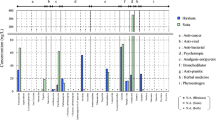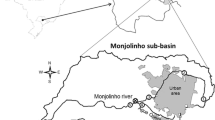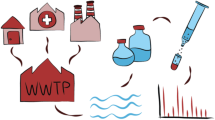Abstract
Pollution status of six anticancer agents in the river water and effluents of sewage treatment plants (STPs) in Japan was surveyed with comparative analysis of the levels of four microbial and one psychotropic pharmaceuticals widely used for therapeutic medication. The area of survey is located in the Kanzaki–Ai River basin which is a major subcatchment of the Yodo River basin and is centered on a highly populated area that includes the middle and downstream reaches of the Yodo River. Selected cancer agents were bicalutamide, capecitabine, cyclophosphamide, doxifluridine, tamoxifen, and tegafur. A combination of strong anion solid-phase extraction cartridge under pH 11 for adsorption and optimization of liquid chromatography–tandem mass spectroscopy (LC–MS/MS) system was necessary to ensure high recovery rates (63–124 % for river water and 52–115 % for STP effluent). The year-round survey of these compounds in four seasons showed that all anticancer compounds were detected at median concentrations ranged from not detected to 32 ng/L in the river water and from not detected to 245 ng/L in the effluents of sewage treatment plants not using ozonation. In the case of bicalutamide (an active antiandrogen used to treat prostate cancer), the maximum concentration detected was 254 ng/L in river water and 1032 ng/L in non-ozonated sewage treatment plant effluents. Based on the mass balance, sewage treatment plants were the primary sources of anticancer compounds as well as the other pharmaceuticals in the river, and the attenuation effect of the river water was small. Ozonation at sewage treatment plants was effective in removing these compounds. To the best of our knowledge, this study is the first to report the existence of bicalutamide, doxifluridine, and tegafur in the river environment.




Similar content being viewed by others
References
Adachi F, Yamamoto A, Takakura K-I, Kawahara R (2013) Occurrence of fluoroquinolones and fluoroquinolone-resistance genes in the aquatic environment. Sci Total Environ 444:508–514
Ågerstrand M, Berg C, Björlenius B, Breitholtz M, Brunström B, Fick J, Gunnarsson L, Larsson DGJ, Sumpter JP, Tysklind M, Rudén C (2015) Improving environmental risk assessment of human pharmaceuticals. Environ Sci Technol 49:5336–5345
American Chemical Society: SciFinder online database (subscription database)
Andreozzi R, Raffaele M, Nicklas P (2003) Pharmaceuticals in STP effluents and their solar photodegradation in aquatic environment. Chemosphere 50:1319–1330
Antoniou MG, Hey G, Rodríguez Vega S, Spiliotopoulou A, Fick J, Tysklind M, la Cour JJ, Andersen HR (2013) Required ozone doses for removing pharmaceuticals from wastewater effluents. Sci Total Environ 456–457:42–49
Aristilde L, Melis A, Sposito G (2010) Inhibition of photosynthesis by a fluoroquinolone antibiotic. Environ Sci Technol 44:1444–1450
Ashton D, Hilton M, Thomas KV (2004) Investigating the environmental transport of human pharmaceuticals to streams in the United Kingdom. Sci Total Environ 333:167–184
Azuma T, Nakada N, Yamashita N, Tanaka H (2012) Synchronous dynamics of observed and predicted values of anti-influenza drugs in environmental waters during a seasonal influenza outbreak. Environ Sci Technol 46:12873–12881
Azuma T, Nakada N, Yamashita N, Tanaka H (2013) Mass balance of anti-influenza drugs discharged into the Yodo River system, Japan, under an influenza outbreak. Chemosphere 93:1672–1677
Azuma T, Nakada N, Yamashita N, Tanaka H (2014) Optimisation of the analysis of anti-influenza drugs in wastewater and surface water. Int J Environ Anal Chem 94:853–862
Besse J-P, Latour J-F, Garric J (2012) Anticancer drugs in surface waters: what can we say about the occurrence and environmental significance of cytotoxic, cytostatic and endocrine therapy drugs? Environ Int 39:73–86
Booker V, Halsall C, Llewellyn N, Johnson A, Williams R (2014) Prioritising anticancer drugs for environmental monitoring and risk assessment purposes. Sci Total Environ 473–474:159–170
Carlsson C, Johansson A-K, Alvan G, Bergman K, Kühler T (2006) Are pharmaceuticals potent environmental pollutants?: part I: environmental risk assessments of selected active pharmaceutical ingredients. Sci Total Environ 364:67–87
Cockshott I (2004) Bicalutamide: clinical pharmacokinetics and metabolism. Clin Pharmacokinet 43:855–878
Daughton CG, Ternes TA (1999) Pharmaceuticals and personal care products in the environment: agents of subtle change? Environ Health Perspect 107:907–938
Environment Canada (2015) Screening assessment, ethanamine, 2-[4-[(1Z)-1,2-diphenyl-1-butenyl]phenoxy]-N,N-dimethyl-(tamoxifen). 1–63
Ferrando-Climent L, Rodriguez-Mozaz S, Barceló D (2013) Development of a UPLC-MS/MS method for the determination of ten anticancer drugs in hospital and urban wastewaters, and its application for the screening of human metabolites assisted by information-dependent acquisition tool (IDA) in sewage samples. Anal Bioanal Chem 405:5937–5952
Ferrando-Climent L, Rodriguez-Mozaz S, Barceló D (2014) Incidence of anticancer drugs in an aquatic urban system: from hospital effluents through urban wastewater to natural environment. Environ Pollut 193:216–223
Ferrer I, Zweigenbaum JA, Thurman EM (2010) Analysis of 70 Environmental Protection Agency priority pharmaceuticals in water by EPA Method 1694. J Chromatogr A 1217:5674–5686
Ghosh GC, Nakada N, Yamashita N, Tanaka H (2010) Oseltamivir carboxylate, the active metabolite of oseltamivir phosphate (Tamiflu), detected in sewage discharge and river water in Japan. Environ Health Perspect 118:103–107
Grabic R, Fick J, Lindberg RH, Fedorova G, Tysklind M (2012) Multi-residue method for trace level determination of pharmaceuticals in environmental samples using liquid chromatography coupled to triple quadrupole mass spectrometry. Talanta 100:183–195
Hanamoto S, Nakada N, Yamashita N, Tanaka H (2013) Modeling the photochemical attenuation of down-the-drain chemicals during river transport by stochastic methods and field measurements of pharmaceuticals and personal care products. Environ Sci Technol 47:13571–13577
Social Welfare and Public Health in Tokyo (2012) Summary of medical practices survey in Tokyo. 1–16
Japan Meteorological Agency, Weather statistics. Available from <http://www.jma.go.jp/jma/index.html> (accessed June 12, 2015)
Jiho (2014) Yakuji Handbook (in Japanese), ISBN: 978-4840743136
Kim I, Yamashita N, Tanaka H (2009a) Performance of UV and UV/H2O2 processes for the removal of pharmaceuticals detected in secondary effluent of a sewage treatment plant in Japan. J Hazard Mater 166:1134–1140
Kim IH, Yamashita N, Kato Y, Tanaka H (2009b) Discussion on the application of UV/H2O2, O3 and O3/UV processes as technologies for sewage reuse considering the removal of pharmaceuticals and personal care products. Water Sci Technol 59:945–955
Kolpin DW, Furlong ET, Meyer MT, Thurman EM, Zaugg SD, Barber LB, Buxton HT (2002) Pharmaceuticals, hormones, and other organic wastewater contaminants in U.S. streams, 1999–2000: a national reconnaissance. Environ Sci Technol 36:1202–1211
Komori K, Suzuki Y, Minamiyama M, Harada A (2013) Occurrence of selected pharmaceuticals in river water in Japan and assessment of their environmental risk. Environ Monit Assess 185:4529–4536
Kosjek T, Heath E (2011) Occurrence, fate and determination of cytostatic pharmaceuticals in the environment. TrAC Trends Anal Chem 30:1065–1087
Kumar V, Nakada N, Yasojima M, Yamashita N, Johnson AC, Tanaka H (2009) Rapid determination of free and conjugated estrogen in different water matrices by liquid chromatography-tandem mass spectrometry. Chemosphere 77:1440–1446
Kumar V, Nakada N, Yamashita N, Johnson AC, Tanaka H (2011) How seasonality affects the flow of estrogens and their conjugates in one of Japan’s most populous catchments. Environ Pollut 159:2906–2912
Kümmerer K (2009) Antibiotics in the aquatic environment—a review—part I. Chemosphere 75:417–434
Lake Biwa-Yodo River Water Quality Preservation Organization, Japan (2012) BYQ (Lake Biwa-Yodo River Water Quality Preservation Organization) Report on water environment in Biwa Lake-Yodo River System 2010 (in Japanese). 1–150
Liu X, Zhang J, Yin J, Duan H, Wu Y, Shao B (2010) Analysis of hormone antagonists in clinical and municipal wastewater by isotopic dilution liquid chromatography tandem mass spectrometry. Anal Bioanal Chem 396:2977–2985
Löffler D, Römbke J, Meller M, Ternes TA (2005) Environmental fate of pharmaceuticals in water/sediment systems. Environ Sci Technol 39:5209–5218
López-Serna R, Jurado A, Vázquez-Suñé E, Carrera J, Petrović M, Barceló D (2013) Occurrence of 95 pharmaceuticals and transformation products in urban groundwaters underlying the metropolis of Barcelona, Spain. Environ Pollut 174:305–315
Martín J, Camacho-Muñoz D, Santos JL, Aparicio I, Alonso E (2011) Simultaneous determination of a selected group of cytostatic drugs in water using high-performance liquid chromatography–triple-quadrupole mass spectrometry. J Sep Sci 34:3166–3177
Ministry of Health Labour and Welfare, Japan (2012) Annual report on statistics of production by pharmaceutical industry in 2011 (in Japanese)
Ministry of Health Labour and Welfare, Japan (2013) Vision of medicine industry 2013 (in Japanese). 1–76
Ministry of Health Labour and Welfare, Japan (2014) Vital statistics in Japan (in Japanese). 1–59
Ministry of the Environment, Japan (2009) Type of environmental standard for water quality for conservation of aquatic organism, 3rd report
Nakada N, Komori K, Suzuki Y, Konishi C, Houwa I, Tanaka H (2007) Occurrence of 70 pharmaceutical and personal care products in Tone River basin in Japan. Water Sci Technol 56:133–140
Narumiya M, Nakada N, Yamashita N, Tanaka H (2013) Phase distribution and removal of pharmaceuticals and personal care products during anaerobic sludge digestion. J Hazard Mater 260:305–312
Negreira N, de Alda ML, Barceló D (2014) Cytostatic drugs and metabolites in municipal and hospital wastewaters in Spain: filtration, occurrence, and environmental risk. Sci Total Environ 497–498:68–77
Nussbaumer S, Bonnabry P, Veuthey J-L, Fleury-Souverain S (2011) Analysis of anticancer drugs: a review. Talanta 85:2265–2289
Okuda T, Yamashita N, Tanaka H, Matsukawa H, Tanabe K (2009) Development of extraction method of pharmaceuticals and their occurrences found in Japanese wastewater treatment plants. Environ Int 35:815–820
Osaka Prefecture, Japan (2012) Yodo River System, river construction plan for Kanzaki River (in Japanese). 1–52
Patrolecco L, Capri S, Ademollo N (2015) Occurrence of selected pharmaceuticals in the principal sewage treatment plants in Rome (Italy) and in the receiving surface waters. Environ Sci Pollut Res 22:5864–5876
Petrović M, Škrbić B, Živančev J, Ferrando-Climent L, Barcelo D (2014) Determination of 81 pharmaceutical drugs by high performance liquid chromatography coupled to mass spectrometry with hybrid triple quadrupole–linear ion trap in different types of water in Serbia. Sci Total Environ 468–469:415–428
Prasse C, Schlüsener MP, Schulz R, Ternes TA (2010) Antiviral drugs in wastewater and surface waters: a new pharmaceutical class of environmental relevance? Environ Sci Technol 44:1728–1735
Rabii FW, Segura PA, Fayad PB, Sauvé S (2014) Determination of six chemotherapeutic agents in municipal wastewater using online solid-phase extraction coupled to liquid chromatography-tandem mass spectrometry. Sci Total Environ 487:792–800
Schlüsener MP, Hardenbicker P, Nilson E, Schulz M, Viergutz C, Ternes TA (2015) Occurrence of venlafaxine, other antidepressants and selected metabolites in the Rhine catchment in the face of climate change. Environ Pollut 196:247–256
Sun L, Chi J, Hu X, Fu Z (2015) Ecotoxicological effects of tamoxifen in the aquatic environment tamoxifen concepts and cancer: new paradigms (cancer etiology, diagnosis and treatments: pharmacology—research, safety testing and regulation). Nova Science Publishers, Inc. Nova Science Publishers, Inc., pp. 47–60
Toolaram AP, Kümmerer K, Schneider M (2014) Environmental risk assessment of anti-cancer drugs and their transformation products: a focus on their genotoxicity characterization-state of knowledge and short comings. Mut Res Rev Mutat Res 760:18–35
Vasquez MI, Lambrianides A, Schneider M, Kümmerer K, Fatta-Kassinos D (2014) Environmental side effects of pharmaceutical cocktails: what we know and what we should know. J Hazard Mater 279:169–189
Yamamoto H, Nakamura Y, Moriguchi S, Nakamura Y, Honda Y, Tamura I, Hirata Y, Hayashi A, Sekizawa J (2009) Persistence and partitioning of eight selected pharmaceuticals in the aquatic environment: laboratory photolysis, biodegradation, and sorption experiments. Water Res 43:351–362
Acknowledgments
We thank the staff of the STPs for sampling the water. We acknowledge the River Foundation for the funding in the form of research and scholarships.
Author information
Authors and Affiliations
Corresponding author
Additional information
Responsible editor: Ester Heath
Rights and permissions
About this article
Cite this article
Azuma, T., Ishiuchi, H., Inoyama, T. et al. Occurrence and fate of selected anticancer, antimicrobial, and psychotropic pharmaceuticals in an urban river in a subcatchment of the Yodo River basin, Japan. Environ Sci Pollut Res 22, 18676–18686 (2015). https://doi.org/10.1007/s11356-015-5013-6
Received:
Accepted:
Published:
Issue Date:
DOI: https://doi.org/10.1007/s11356-015-5013-6




